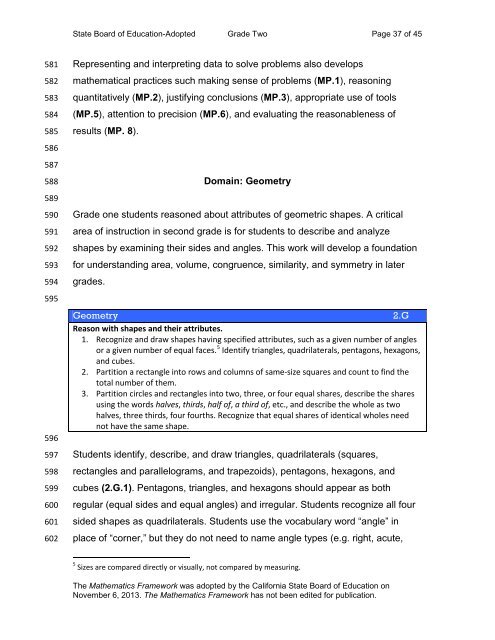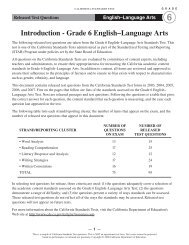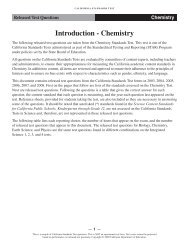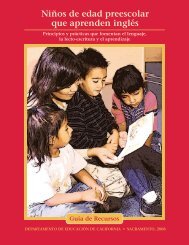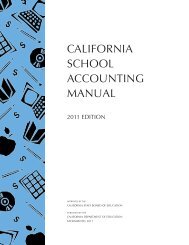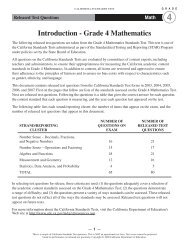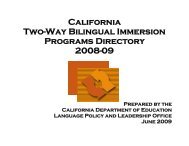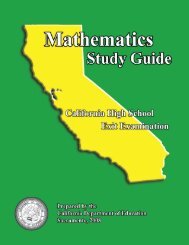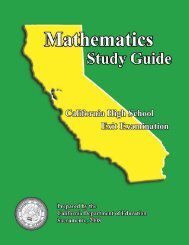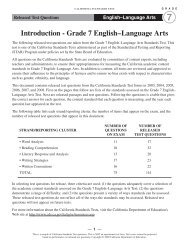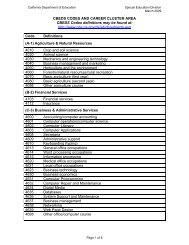Grade 2 - California Department of Education
Grade 2 - California Department of Education
Grade 2 - California Department of Education
Create successful ePaper yourself
Turn your PDF publications into a flip-book with our unique Google optimized e-Paper software.
State Board <strong>of</strong> <strong>Education</strong>-Adopted <strong>Grade</strong> Two Page 37 <strong>of</strong> 45<br />
581<br />
582<br />
583<br />
584<br />
585<br />
586<br />
587<br />
588<br />
589<br />
590<br />
591<br />
592<br />
593<br />
594<br />
595<br />
596<br />
597<br />
598<br />
599<br />
600<br />
601<br />
602<br />
Representing and interpreting data to solve problems also develops<br />
mathematical practices such making sense <strong>of</strong> problems (MP.1), reasoning<br />
quantitatively (MP.2), justifying conclusions (MP.3), appropriate use <strong>of</strong> tools<br />
(MP.5), attention to precision (MP.6), and evaluating the reasonableness <strong>of</strong><br />
results (MP. 8).<br />
Domain: Geometry<br />
<strong>Grade</strong> one students reasoned about attributes <strong>of</strong> geometric shapes. A critical<br />
area <strong>of</strong> instruction in second grade is for students to describe and analyze<br />
shapes by examining their sides and angles. This work will develop a foundation<br />
for understanding area, volume, congruence, similarity, and symmetry in later<br />
grades.<br />
Geometry 2.G<br />
Reason with shapes and their attributes.<br />
1. Recognize and draw shapes having specified attributes, such as a given number <strong>of</strong> angles<br />
or a given number <strong>of</strong> equal faces. 5 Identify triangles, quadrilaterals, pentagons, hexagons,<br />
and cubes.<br />
2. Partition a rectangle into rows and columns <strong>of</strong> same-size squares and count to find the<br />
total number <strong>of</strong> them.<br />
3. Partition circles and rectangles into two, three, or four equal shares, describe the shares<br />
using the words halves, thirds, half <strong>of</strong>, a third <strong>of</strong>, etc., and describe the whole as two<br />
halves, three thirds, four fourths. Recognize that equal shares <strong>of</strong> identical wholes need<br />
not have the same shape.<br />
Students identify, describe, and draw triangles, quadrilaterals (squares,<br />
rectangles and parallelograms, and trapezoids), pentagons, hexagons, and<br />
cubes (2.G.1). Pentagons, triangles, and hexagons should appear as both<br />
regular (equal sides and equal angles) and irregular. Students recognize all four<br />
sided shapes as quadrilaterals. Students use the vocabulary word “angle” in<br />
place <strong>of</strong> “corner,” but they do not need to name angle types (e.g. right, acute,<br />
5 Sizes are compared directly or visually, not compared by measuring.<br />
The Mathematics Framework was adopted by the <strong>California</strong> State Board <strong>of</strong> <strong>Education</strong> on<br />
November 6, 2013. The Mathematics Framework has not been edited for publication.


